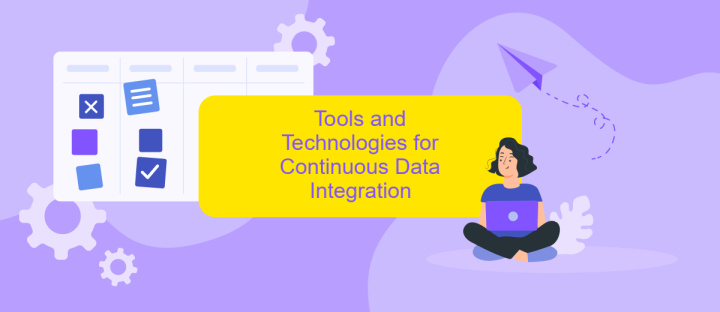Continuous Data Integration
Continuous Data Integration (CDI) represents a transformative approach in the realm of data management, enabling organizations to seamlessly merge and update data from various sources in real-time. By automating data workflows and ensuring consistent data quality, CDI empowers businesses to make informed decisions swiftly, enhancing operational efficiency and driving innovation across multiple domains.
Introduction
Continuous Data Integration is a crucial practice in modern software development, enabling teams to merge code changes frequently and detect issues early. This approach enhances collaboration and ensures that the codebase remains in a deployable state. By automating the integration process, developers can focus on writing code rather than resolving conflicts.
- Automated builds and tests
- Early detection of integration issues
- Improved collaboration among team members
- Faster delivery of features and bug fixes
To streamline Continuous Data Integration, tools like ApiX-Drive can be utilized. ApiX-Drive offers seamless integration capabilities, allowing developers to connect various services and automate workflows effortlessly. By leveraging such tools, teams can maintain a high level of productivity and ensure that their integration processes are efficient and reliable.
Benefits of Continuous Data Integration

Continuous Data Integration (CDI) offers numerous advantages, particularly in enhancing data accuracy and consistency across various systems. By automating data synchronization, CDI minimizes the risks of human error, ensuring that all data points are up-to-date and reliable. This continuous process allows organizations to make more informed decisions, as they can trust the integrity of their data. Additionally, CDI facilitates real-time data access, which is crucial for dynamic environments that require immediate insights and actions.
Another significant benefit of CDI is the streamlined workflow and improved efficiency it brings to data management. Tools like ApiX-Drive simplify the integration process by providing a user-friendly platform to connect various applications and data sources without extensive coding. This not only saves time but also reduces the need for specialized technical skills, making it accessible to a broader range of users. Consequently, businesses can quickly adapt to evolving data needs and maintain a competitive edge in their respective industries.
Tools and Technologies for Continuous Data Integration

Continuous Data Integration (CDI) is essential for maintaining data consistency and reliability across various systems. To achieve this, a variety of tools and technologies are employed, each catering to different aspects of the integration process.
- ETL Tools: Tools like Apache NiFi, Talend, and Informatica facilitate Extract, Transform, Load (ETL) processes, ensuring data is accurately transferred and transformed between systems.
- Data Integration Platforms: Solutions such as MuleSoft and Dell Boomi provide comprehensive platforms for integrating data across diverse environments, including cloud and on-premises systems.
- API Integration Services: ApiX-Drive is a versatile service that simplifies the integration of various applications through APIs, enabling seamless data flow and synchronization.
- Data Orchestration Tools: Apache Airflow and Prefect help manage and automate complex data workflows, ensuring timely and reliable data integration.
By leveraging these tools and technologies, organizations can streamline their data integration processes, resulting in improved data quality, reduced manual intervention, and enhanced decision-making capabilities. Whether using ETL tools, comprehensive platforms, or specialized API services like ApiX-Drive, each plays a crucial role in achieving effective Continuous Data Integration.
Challenges and Considerations

Continuous Data Integration (CDI) poses several challenges that organizations must address to ensure seamless data flow and system efficiency. One of the primary challenges is data consistency, as integrating data from multiple sources can lead to discrepancies and conflicts. Ensuring that data remains accurate and up-to-date across all systems is crucial for reliable decision-making.
Another significant consideration is the scalability of the integration process. As organizations grow, the volume of data and the number of integration points increase, requiring robust solutions to handle the expanding workload without compromising performance. Additionally, security concerns must be addressed to protect sensitive data during transfer and integration.
- Data consistency and accuracy
- Scalability of integration processes
- Security of data during transfer
- Real-time data synchronization
Utilizing integration services like ApiX-Drive can help mitigate these challenges by providing automated, scalable, and secure data integration solutions. ApiX-Drive simplifies the process by connecting various applications and ensuring real-time data synchronization, thereby enhancing overall system efficiency and reliability.


Best Practices and Next Steps
Implementing best practices in Continuous Data Integration (CDI) is crucial for maintaining data accuracy and consistency. Start by automating data workflows to minimize manual interventions and errors. Utilize robust version control systems to track changes and ensure that all team members are working with the most up-to-date data. Regularly monitor data quality and set up alerts for any discrepancies or anomalies. Incorporate comprehensive testing phases to validate data integrity at each step of the integration process.
For next steps, consider leveraging tools like ApiX-Drive to streamline your CDI efforts. ApiX-Drive simplifies the integration process by offering a user-friendly interface and pre-built connectors for various data sources. This can significantly reduce the time and effort required to set up and maintain integrations. Additionally, focus on scalability by designing your integration architecture to handle increasing data volumes and complexity. Continuous education and training for your team on the latest CDI tools and methodologies will also ensure ongoing improvement and adaptation to new technologies.
FAQ
What is Continuous Data Integration (CDI)?
Why is CDI important for businesses?
How can CDI be implemented in an organization?
What are the challenges of CDI?
What tools or services can assist with CDI?
Do you want to achieve your goals in business, career and life faster and better? Do it with ApiX-Drive – a tool that will remove a significant part of the routine from workflows and free up additional time to achieve your goals. Test the capabilities of Apix-Drive for free – see for yourself the effectiveness of the tool.

